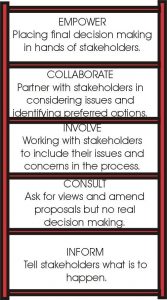![]() This article is part of our toolbox
This article is part of our toolbox
“Tackling waste in tourism & events”
You have decided to work at reducing waste in your tourism/events organization ? Welcome on board! After having completed the four key steps of our guiding methodology, it’s now time to select the top priority solutions you’d like to adress. The objective is not to tackle everything at once, but to focus your energy on key/easy tasks to start with!
Why?
- Priorize to maximise: your resources both human and financial are limited. Thus ensure to priorise them where they will have the most impact.
- You will not have time to make everything perfect at once. but remember that Zero waste philosophy aims at getting better with time, step by step.
- The first steps and success will help you over time to convince and get more people on board. For example, depending of their initial motivation, will be easier to convince hierarchy for small steps and get a proof of concept before going big.
How to prioritize
your actions?
Steps:
Tools:
1. Determine your waste stream priorities
As you cannot to everything at once, try to determinate the waste stream you sould priorize, based on your original motives to launch this project (see step 1) :
- To reduce your environmental footprint ? check the audit template grid to determine your highest source of waste, especially the ones that currently don’t enter circular systems
- To get a certification ? check what are their criterias (for example, biowaste management is often cumpulsory).
- To reduce your waste costs ? check again you audit
- For aesthetic and client image ? determine which are the waste most visible, such as litter on the beach/garden, straws, …
- To comply with the law ? check which one are cumpulsory, and the other that you can do in a second step
- and so on
- With those elements in mind,, try to rank them by priorities, to help define your actions. KYou might keep using the audit template which has a priority column
2. Short-list solutions for action
Once you hav your waste strem priorities, you should start digging into the solutions: Try to list
- Existing actions that could be either improved or extended.
- New solutions that you could implement, explore our waste streams solutions articles and/or have a quick overview at our recap list.
- Changing unsustainable practices by discussing with your partners and suppliers.
- Actions that have been suggested by your internal and external stakeholders (see step 2 and step 4)
Keep in mind 3 main criterias for your solutions:
Impacting solutions
Amongst the many options available remember to give priority if possible to the ones that bring stronger ecological and social impact
Pragmatic solutions
Be pragmatic about the potential human and financial resources you will have to mobilize. If you have the resources, it’s of course better to invest with long term solutions. If you don’t have much resources, you might want to do less or easier tasks the first time rather, than being too ambitious and taking the risk to give it all up.
Engaging solutions
Take a step back on the feedback you collected from your internal brainstorming session with employees and during the sensedrink your organized with external stakeholders. Make a selection of the key actions which were the most recurrent.
3. Select your solutions for action
You now have a grid with many solutions. It’s time to select the ones you will implement first.
The responsibility to decide to take actions can vary very differently in-between organisations…but in all cases, we recommend to :
Prepare for the decision
- Ask your top hierarchy opinion about the coefficient you suggested for weighing the different criteria.
- Make different coherent scenarii to combine several solutions that could work together
- Give details about potential costs and benefits
Take decision
Depending on the governance system you evolve in you can either start acting by yourself, get a validation of your hierarchy or have more participative ways with internal and external stakeholders. (See our step 6 on collaborative action plans!)
Step by step: continuous improvement
Remember that it is normal to act gradually, and that you don’t have to do everything at once. When your solutions are successfully implemented, celebrate, and start the process again from this step, picking up new solutions to go ahead with 😀
![]() This article is part of our toolbox
This article is part of our toolbox
“Tackling waste in tourism & events”
Main author of this article:

Thanks to all our authors and co-authors, as well as our experts and proofreaders, who contributed to improve the content or our articles. Like the entire toolbox, this article has been created collaboratively with :

 Source:
Source: 



 Enter your address to have adapted content
Enter your address to have adapted content

Find us